Intermediate Economics Assignment: Utility and Budget Constraints
VerifiedAdded on 2019/11/20
|10
|1259
|320
Homework Assignment
AI Summary
This economics assignment delves into consumer behavior, analyzing how individuals make choices within budget constraints and maximize utility. Problem 1 examines a family's consumption of two goods, exploring budget lines, indifference curves, and the impact of a voucher system on optimal consumption. Problem 2 introduces a quasi-linear utility function, investigating the marginal rate of substitution and consumer choices with varying incomes and prices. Problem 3 focuses on a utility function with perfect substitutes, assessing the effects of price changes on consumer behavior, substitution, and income effects, and identifying whether goods are Giffen or normal. The assignment utilizes graphs, tables, and mathematical calculations to illustrate economic principles and provide detailed solutions to each problem.
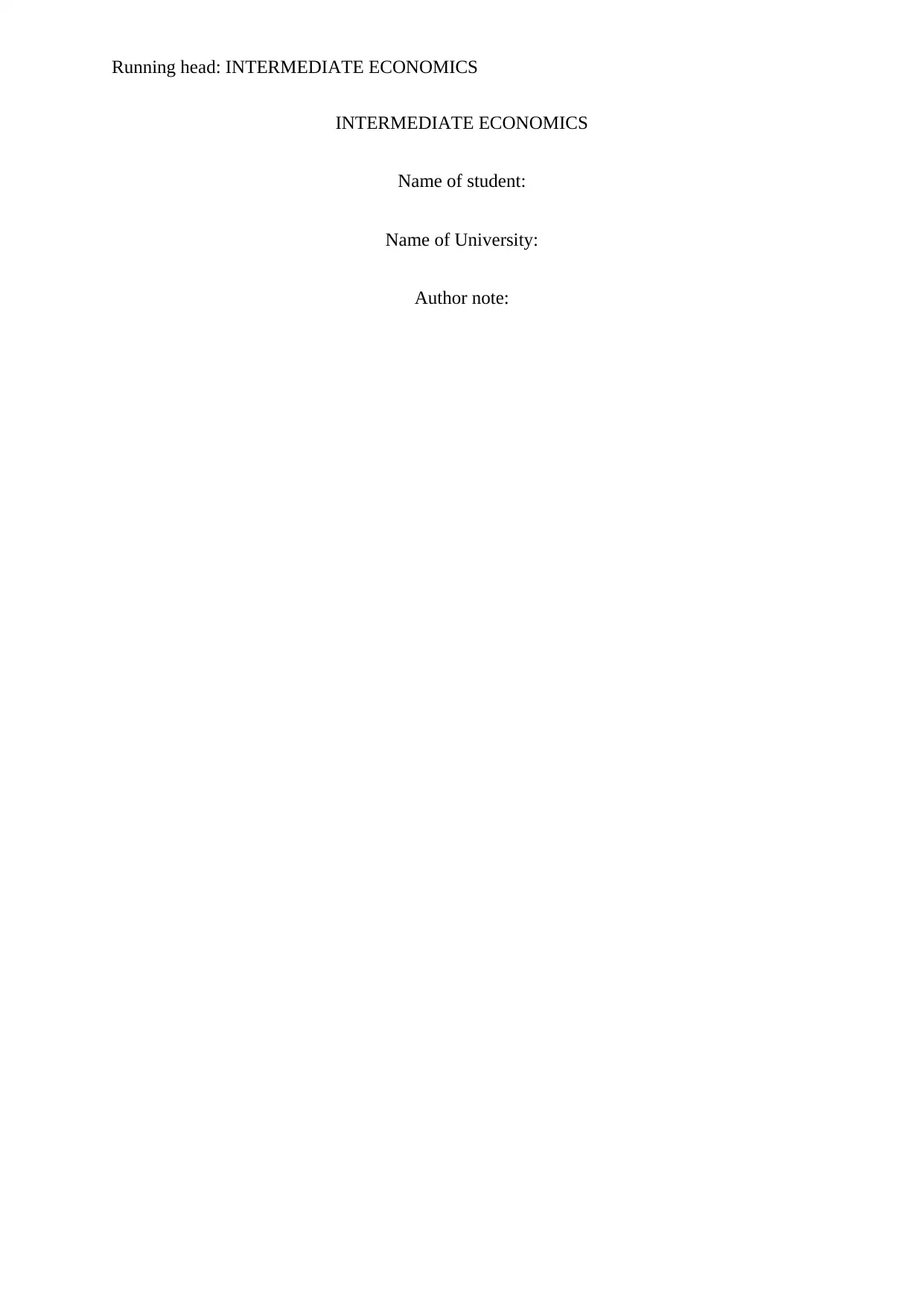
Running head: INTERMEDIATE ECONOMICS
INTERMEDIATE ECONOMICS
Name of student:
Name of University:
Author note:
INTERMEDIATE ECONOMICS
Name of student:
Name of University:
Author note:
Paraphrase This Document
Need a fresh take? Get an instant paraphrase of this document with our AI Paraphraser
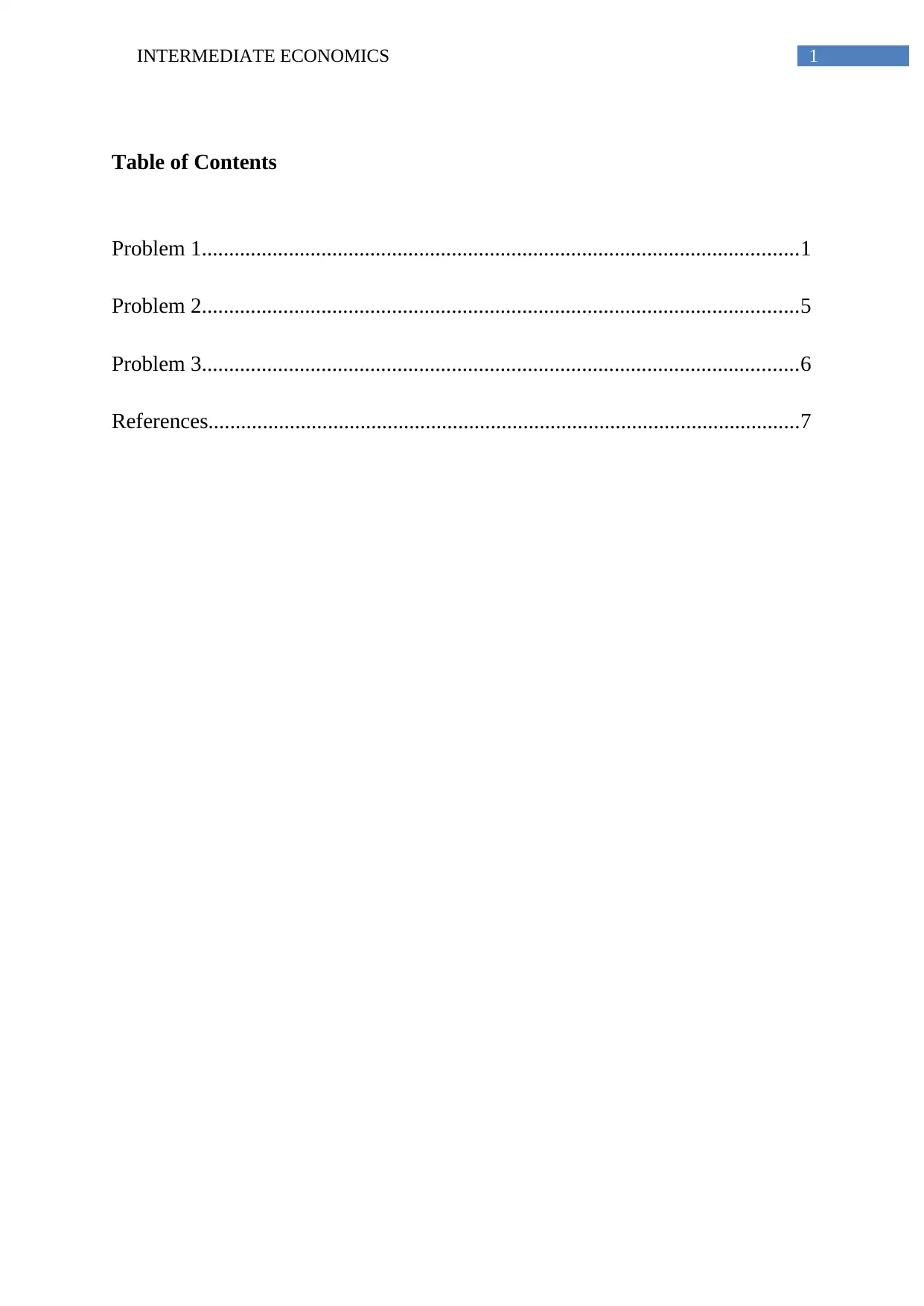
1INTERMEDIATE ECONOMICS
Table of Contents
Problem 1..............................................................................................................1
Problem 2..............................................................................................................5
Problem 3..............................................................................................................6
References.............................................................................................................7
Table of Contents
Problem 1..............................................................................................................1
Problem 2..............................................................................................................5
Problem 3..............................................................................................................6
References.............................................................................................................7
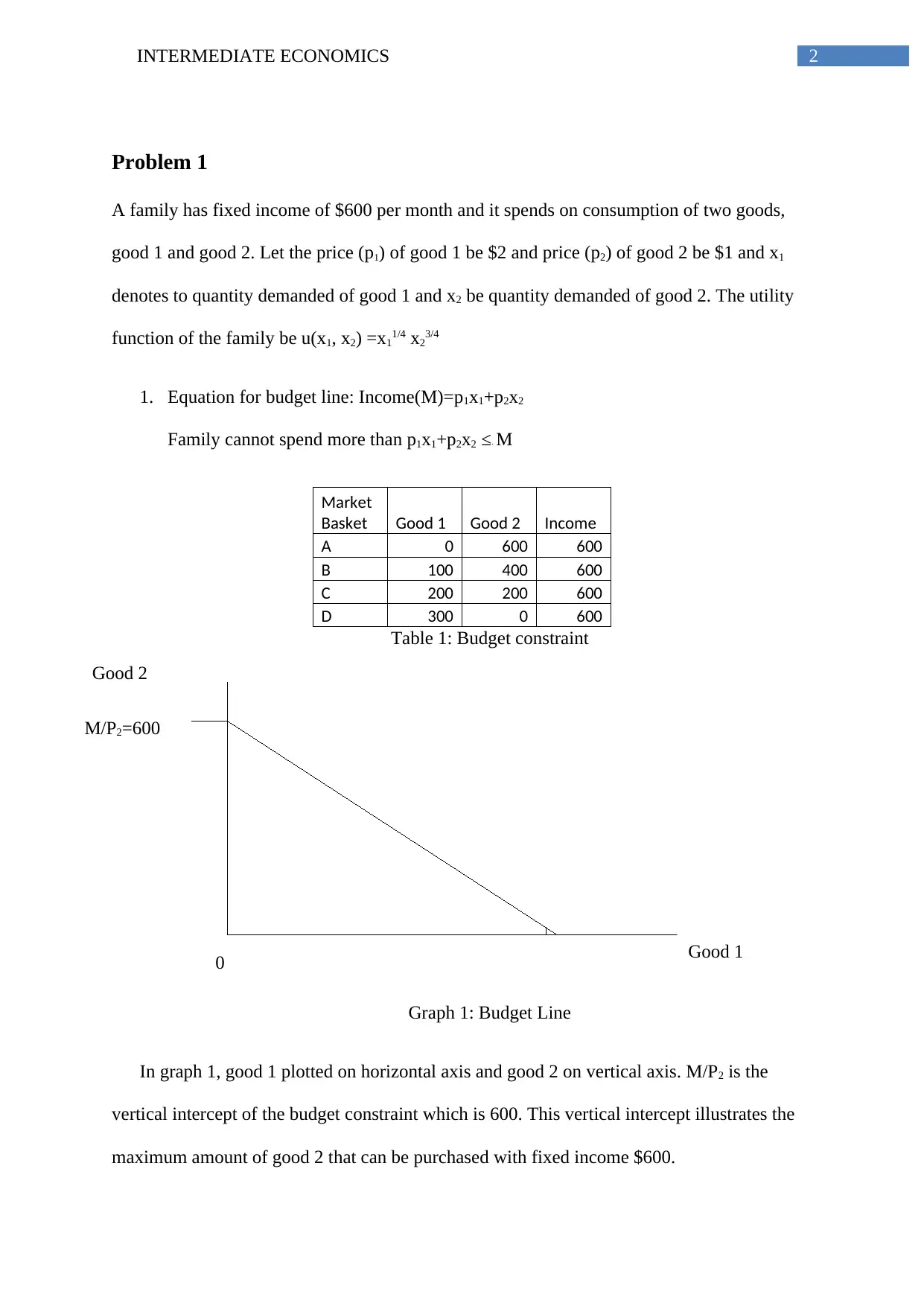
2INTERMEDIATE ECONOMICS
Good 1
0
Problem 1
A family has fixed income of $600 per month and it spends on consumption of two goods,
good 1 and good 2. Let the price (p1) of good 1 be $2 and price (p2) of good 2 be $1 and x1
denotes to quantity demanded of good 1 and x2 be quantity demanded of good 2. The utility
function of the family be u(x1, x2) =x11/4 x23/4
1. Equation for budget line: Income(M)=p1x1+p2x2
Family cannot spend more than p1x1+p2x2 ≤ M
Market
Basket Good 1 Good 2 Income
A 0 600 600
B 100 400 600
C 200 200 600
D 300 0 600
Table 1: Budget constraint
Graph 1: Budget Line
In graph 1, good 1 plotted on horizontal axis and good 2 on vertical axis. M/P2 is the
vertical intercept of the budget constraint which is 600. This vertical intercept illustrates the
maximum amount of good 2 that can be purchased with fixed income $600.
Good 2
M/P2=600
Good 1
0
Problem 1
A family has fixed income of $600 per month and it spends on consumption of two goods,
good 1 and good 2. Let the price (p1) of good 1 be $2 and price (p2) of good 2 be $1 and x1
denotes to quantity demanded of good 1 and x2 be quantity demanded of good 2. The utility
function of the family be u(x1, x2) =x11/4 x23/4
1. Equation for budget line: Income(M)=p1x1+p2x2
Family cannot spend more than p1x1+p2x2 ≤ M
Market
Basket Good 1 Good 2 Income
A 0 600 600
B 100 400 600
C 200 200 600
D 300 0 600
Table 1: Budget constraint
Graph 1: Budget Line
In graph 1, good 1 plotted on horizontal axis and good 2 on vertical axis. M/P2 is the
vertical intercept of the budget constraint which is 600. This vertical intercept illustrates the
maximum amount of good 2 that can be purchased with fixed income $600.
Good 2
M/P2=600
⊘ This is a preview!⊘
Do you want full access?
Subscribe today to unlock all pages.

Trusted by 1+ million students worldwide
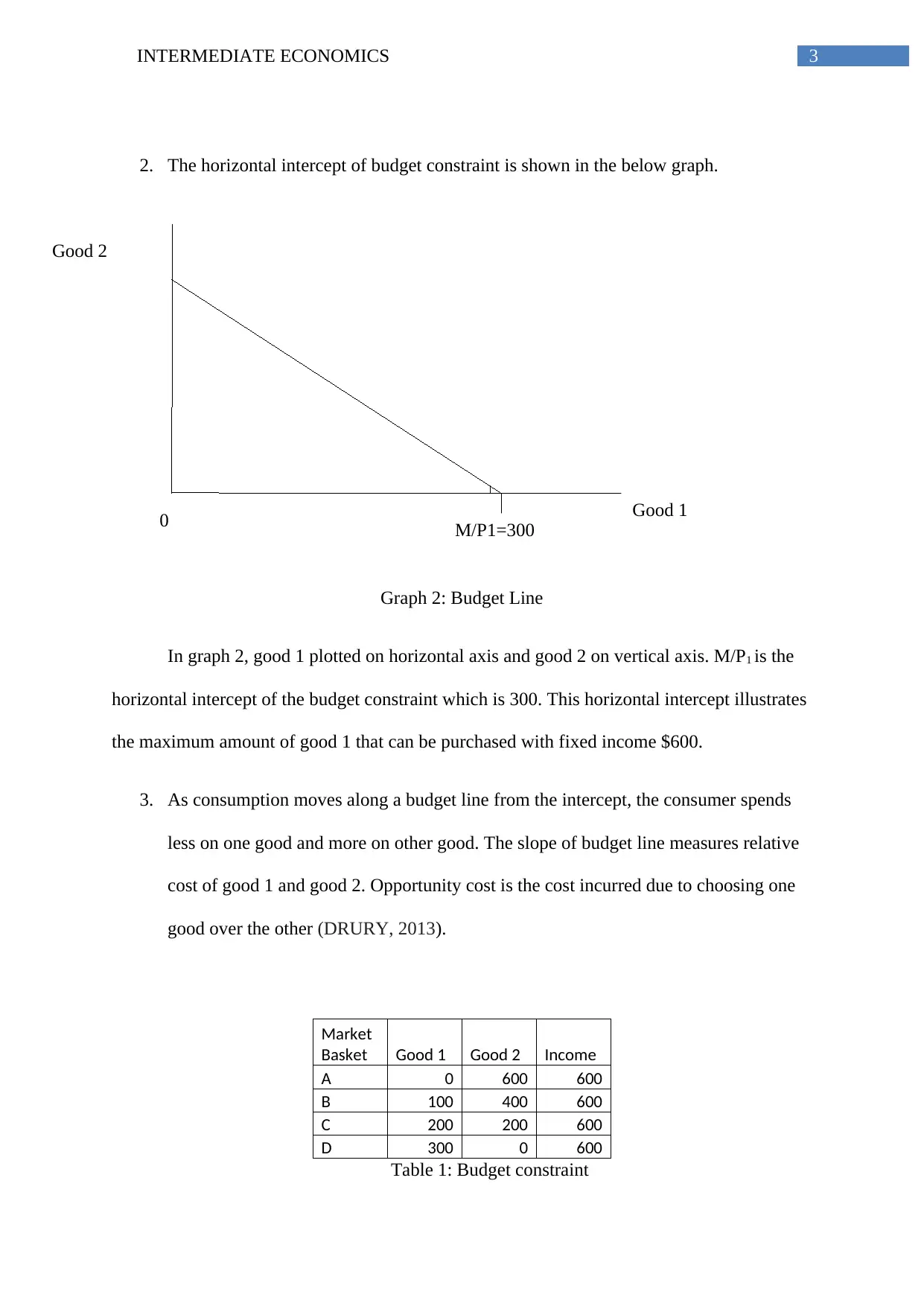
3INTERMEDIATE ECONOMICS
Good 1
0 M/P1=300
2. The horizontal intercept of budget constraint is shown in the below graph.
Graph 2: Budget Line
In graph 2, good 1 plotted on horizontal axis and good 2 on vertical axis. M/P1 is the
horizontal intercept of the budget constraint which is 300. This horizontal intercept illustrates
the maximum amount of good 1 that can be purchased with fixed income $600.
3. As consumption moves along a budget line from the intercept, the consumer spends
less on one good and more on other good. The slope of budget line measures relative
cost of good 1 and good 2. Opportunity cost is the cost incurred due to choosing one
good over the other (DRURY, 2013).
Market
Basket Good 1 Good 2 Income
A 0 600 600
B 100 400 600
C 200 200 600
D 300 0 600
Table 1: Budget constraint
Good 2
Good 1
0 M/P1=300
2. The horizontal intercept of budget constraint is shown in the below graph.
Graph 2: Budget Line
In graph 2, good 1 plotted on horizontal axis and good 2 on vertical axis. M/P1 is the
horizontal intercept of the budget constraint which is 300. This horizontal intercept illustrates
the maximum amount of good 1 that can be purchased with fixed income $600.
3. As consumption moves along a budget line from the intercept, the consumer spends
less on one good and more on other good. The slope of budget line measures relative
cost of good 1 and good 2. Opportunity cost is the cost incurred due to choosing one
good over the other (DRURY, 2013).
Market
Basket Good 1 Good 2 Income
A 0 600 600
B 100 400 600
C 200 200 600
D 300 0 600
Table 1: Budget constraint
Good 2
Paraphrase This Document
Need a fresh take? Get an instant paraphrase of this document with our AI Paraphraser
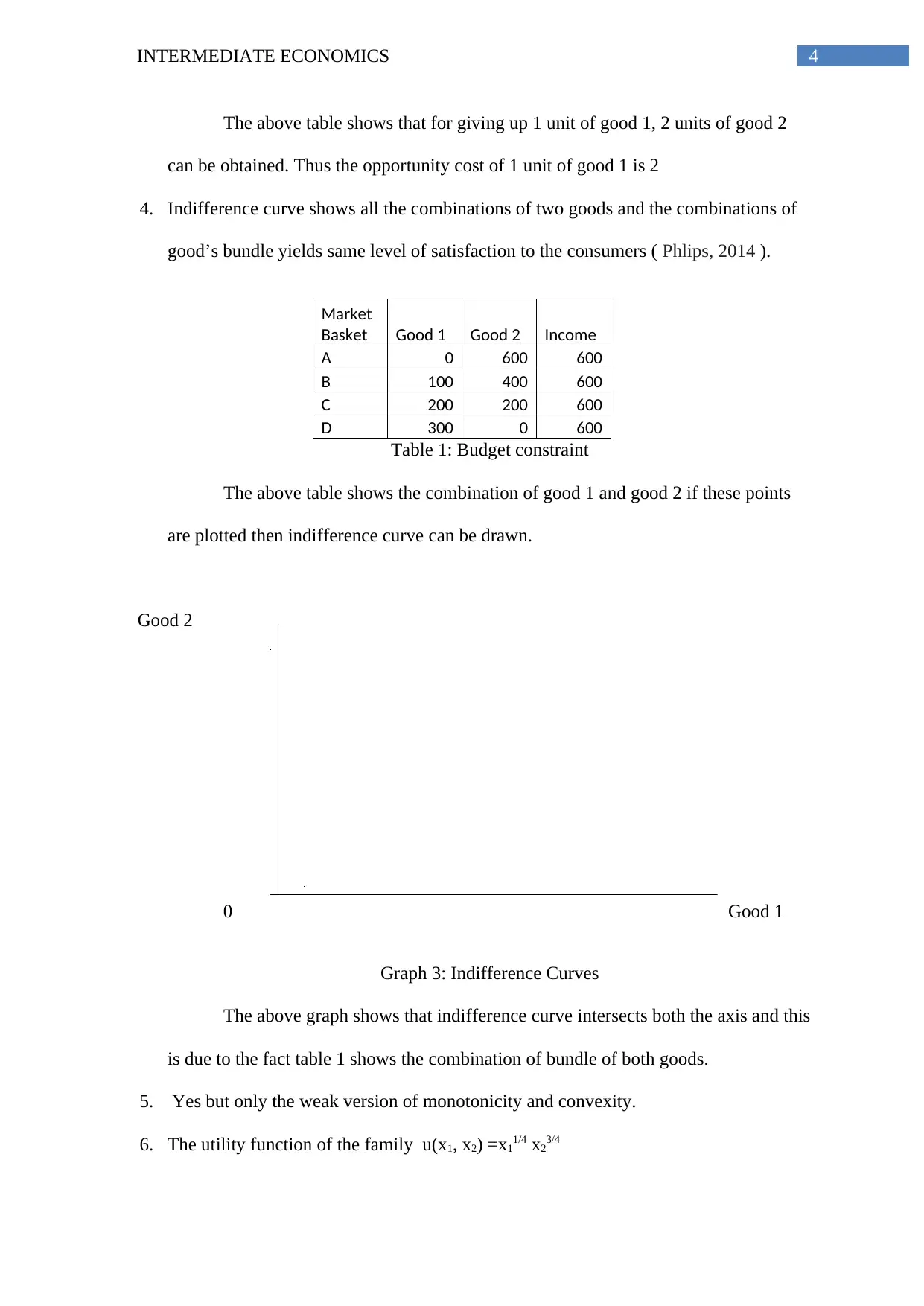
4INTERMEDIATE ECONOMICS
Good 1
The above table shows that for giving up 1 unit of good 1, 2 units of good 2
can be obtained. Thus the opportunity cost of 1 unit of good 1 is 2
4. Indifference curve shows all the combinations of two goods and the combinations of
good’s bundle yields same level of satisfaction to the consumers ( Phlips, 2014 ).
Market
Basket Good 1 Good 2 Income
A 0 600 600
B 100 400 600
C 200 200 600
D 300 0 600
Table 1: Budget constraint
The above table shows the combination of good 1 and good 2 if these points
are plotted then indifference curve can be drawn.
Graph 3: Indifference Curves
The above graph shows that indifference curve intersects both the axis and this
is due to the fact table 1 shows the combination of bundle of both goods.
5. Yes but only the weak version of monotonicity and convexity.
6. The utility function of the family u(x1, x2) =x11/4 x23/4
Good 2
0
Good 1
The above table shows that for giving up 1 unit of good 1, 2 units of good 2
can be obtained. Thus the opportunity cost of 1 unit of good 1 is 2
4. Indifference curve shows all the combinations of two goods and the combinations of
good’s bundle yields same level of satisfaction to the consumers ( Phlips, 2014 ).
Market
Basket Good 1 Good 2 Income
A 0 600 600
B 100 400 600
C 200 200 600
D 300 0 600
Table 1: Budget constraint
The above table shows the combination of good 1 and good 2 if these points
are plotted then indifference curve can be drawn.
Graph 3: Indifference Curves
The above graph shows that indifference curve intersects both the axis and this
is due to the fact table 1 shows the combination of bundle of both goods.
5. Yes but only the weak version of monotonicity and convexity.
6. The utility function of the family u(x1, x2) =x11/4 x23/4
Good 2
0
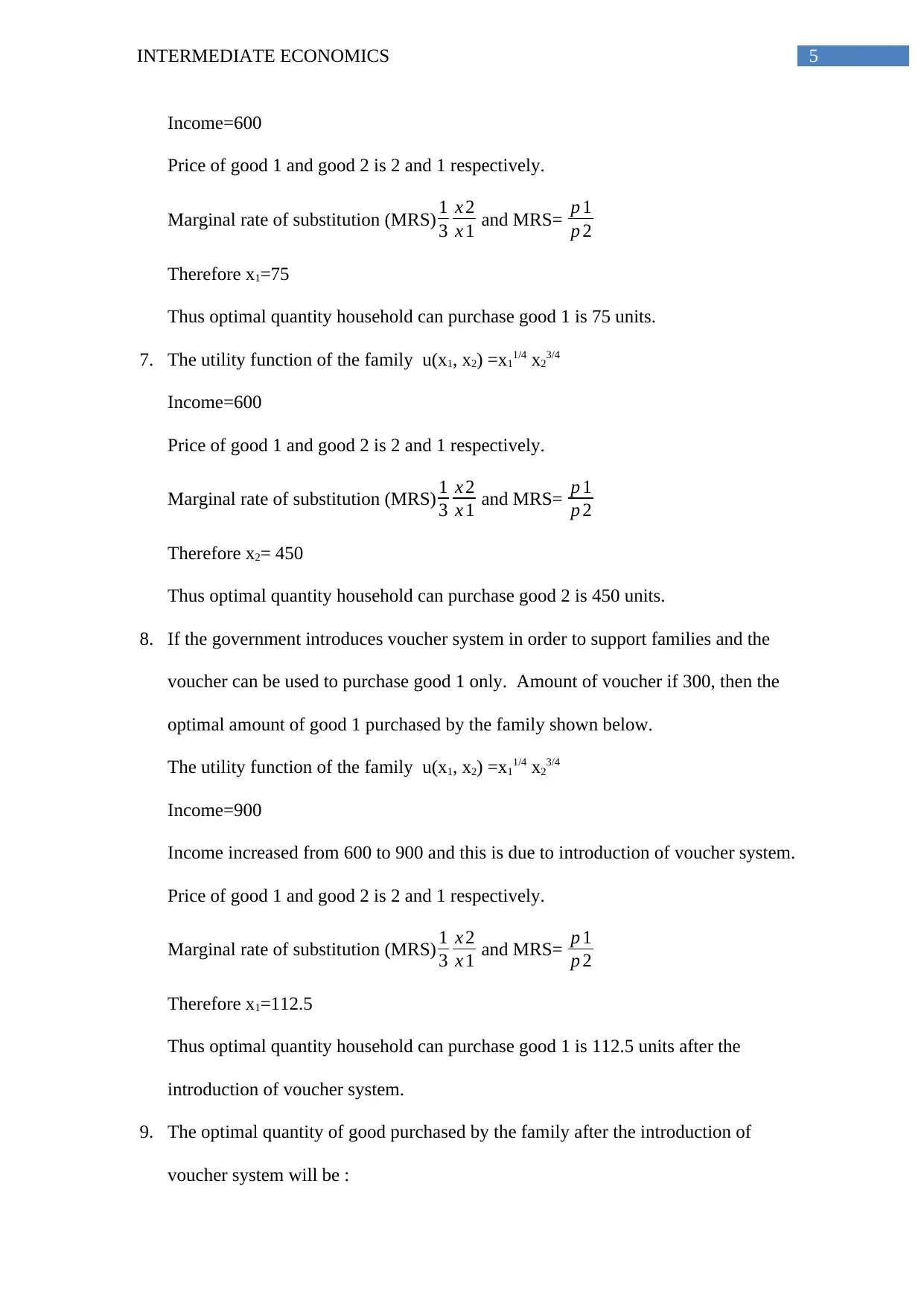
5INTERMEDIATE ECONOMICS
Income=600
Price of good 1 and good 2 is 2 and 1 respectively.
Marginal rate of substitution (MRS) 1
3
x 2
x 1 and MRS= p 1
p 2
Therefore x1=75
Thus optimal quantity household can purchase good 1 is 75 units.
7. The utility function of the family u(x1, x2) =x11/4 x23/4
Income=600
Price of good 1 and good 2 is 2 and 1 respectively.
Marginal rate of substitution (MRS) 1
3
x 2
x 1 and MRS= p 1
p 2
Therefore x2= 450
Thus optimal quantity household can purchase good 2 is 450 units.
8. If the government introduces voucher system in order to support families and the
voucher can be used to purchase good 1 only. Amount of voucher if 300, then the
optimal amount of good 1 purchased by the family shown below.
The utility function of the family u(x1, x2) =x11/4 x23/4
Income=900
Income increased from 600 to 900 and this is due to introduction of voucher system.
Price of good 1 and good 2 is 2 and 1 respectively.
Marginal rate of substitution (MRS) 1
3
x 2
x 1 and MRS= p 1
p 2
Therefore x1=112.5
Thus optimal quantity household can purchase good 1 is 112.5 units after the
introduction of voucher system.
9. The optimal quantity of good purchased by the family after the introduction of
voucher system will be :
Income=600
Price of good 1 and good 2 is 2 and 1 respectively.
Marginal rate of substitution (MRS) 1
3
x 2
x 1 and MRS= p 1
p 2
Therefore x1=75
Thus optimal quantity household can purchase good 1 is 75 units.
7. The utility function of the family u(x1, x2) =x11/4 x23/4
Income=600
Price of good 1 and good 2 is 2 and 1 respectively.
Marginal rate of substitution (MRS) 1
3
x 2
x 1 and MRS= p 1
p 2
Therefore x2= 450
Thus optimal quantity household can purchase good 2 is 450 units.
8. If the government introduces voucher system in order to support families and the
voucher can be used to purchase good 1 only. Amount of voucher if 300, then the
optimal amount of good 1 purchased by the family shown below.
The utility function of the family u(x1, x2) =x11/4 x23/4
Income=900
Income increased from 600 to 900 and this is due to introduction of voucher system.
Price of good 1 and good 2 is 2 and 1 respectively.
Marginal rate of substitution (MRS) 1
3
x 2
x 1 and MRS= p 1
p 2
Therefore x1=112.5
Thus optimal quantity household can purchase good 1 is 112.5 units after the
introduction of voucher system.
9. The optimal quantity of good purchased by the family after the introduction of
voucher system will be :
⊘ This is a preview!⊘
Do you want full access?
Subscribe today to unlock all pages.

Trusted by 1+ million students worldwide
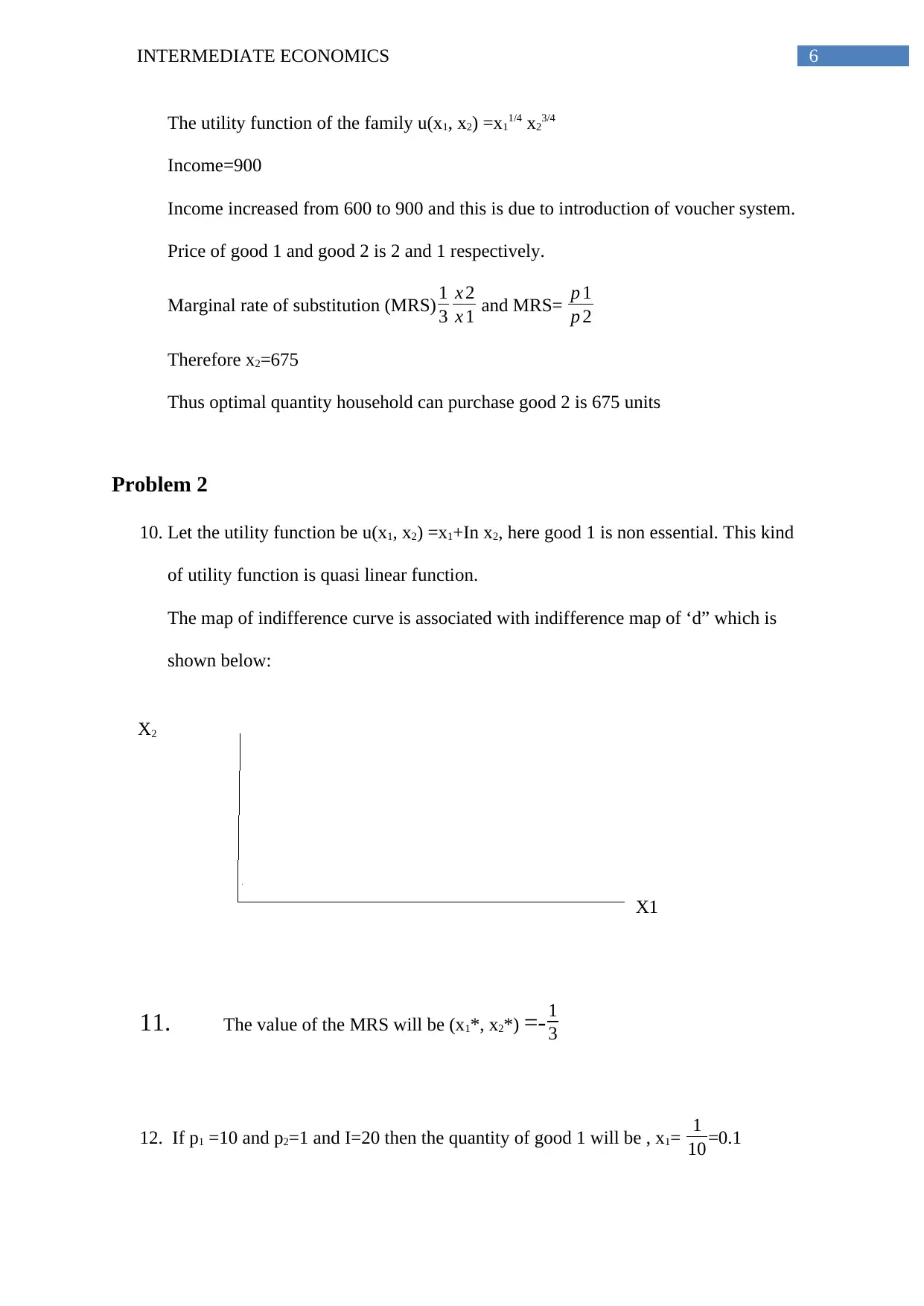
6INTERMEDIATE ECONOMICS
X1
The utility function of the family u(x1, x2) =x11/4 x23/4
Income=900
Income increased from 600 to 900 and this is due to introduction of voucher system.
Price of good 1 and good 2 is 2 and 1 respectively.
Marginal rate of substitution (MRS) 1
3
x 2
x 1 and MRS= p 1
p 2
Therefore x2=675
Thus optimal quantity household can purchase good 2 is 675 units
Problem 2
10. Let the utility function be u(x1, x2) =x1+In x2, here good 1 is non essential. This kind
of utility function is quasi linear function.
The map of indifference curve is associated with indifference map of ‘d” which is
shown below:
11. The value of the MRS will be (x1*, x2*) =-1
3
12. If p1 =10 and p2=1 and I=20 then the quantity of good 1 will be , x1= 1
10=0.1
X2
X1
The utility function of the family u(x1, x2) =x11/4 x23/4
Income=900
Income increased from 600 to 900 and this is due to introduction of voucher system.
Price of good 1 and good 2 is 2 and 1 respectively.
Marginal rate of substitution (MRS) 1
3
x 2
x 1 and MRS= p 1
p 2
Therefore x2=675
Thus optimal quantity household can purchase good 2 is 675 units
Problem 2
10. Let the utility function be u(x1, x2) =x1+In x2, here good 1 is non essential. This kind
of utility function is quasi linear function.
The map of indifference curve is associated with indifference map of ‘d” which is
shown below:
11. The value of the MRS will be (x1*, x2*) =-1
3
12. If p1 =10 and p2=1 and I=20 then the quantity of good 1 will be , x1= 1
10=0.1
X2
Paraphrase This Document
Need a fresh take? Get an instant paraphrase of this document with our AI Paraphraser
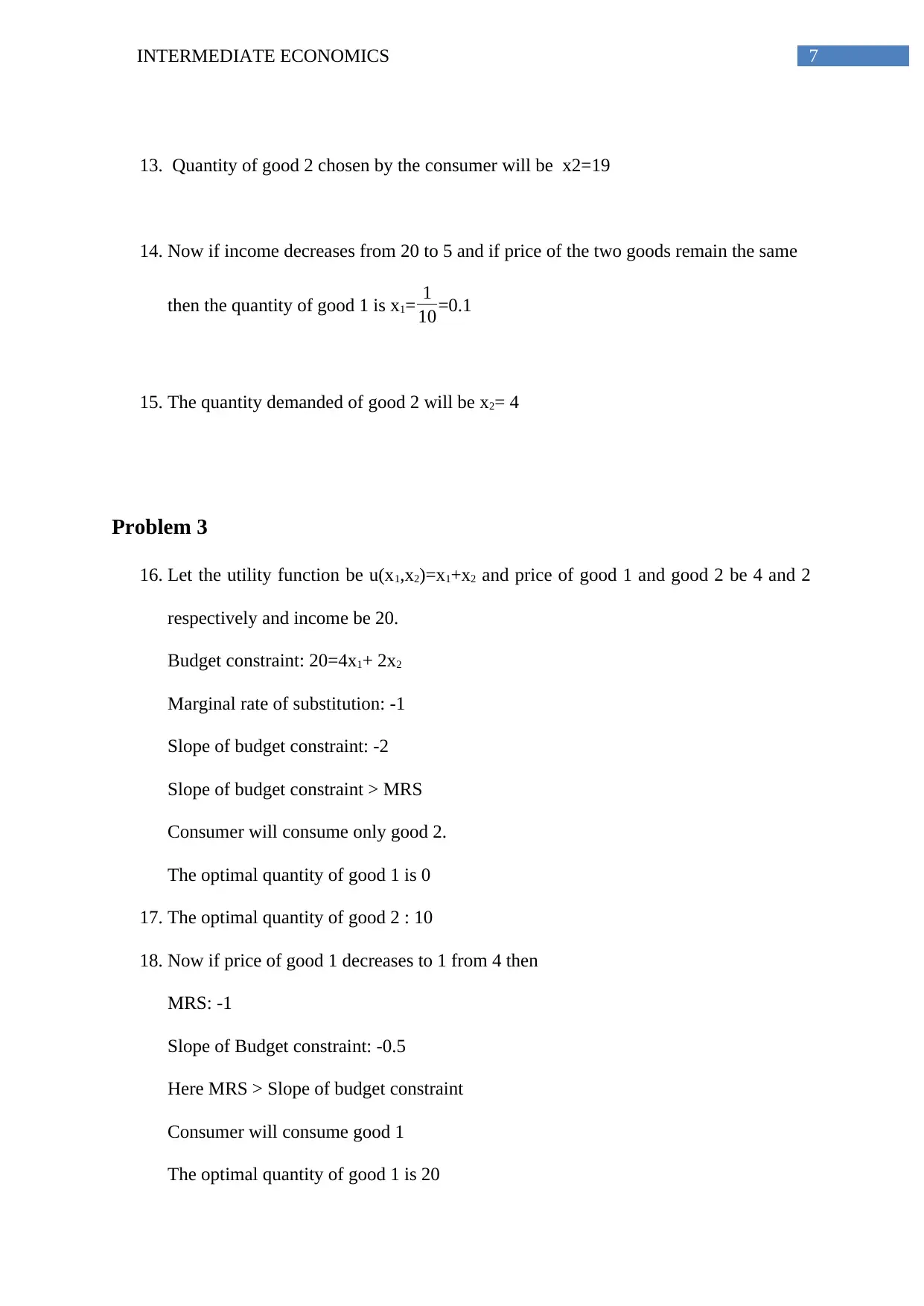
7INTERMEDIATE ECONOMICS
13. Quantity of good 2 chosen by the consumer will be x2=19
14. Now if income decreases from 20 to 5 and if price of the two goods remain the same
then the quantity of good 1 is x1= 1
10=0.1
15. The quantity demanded of good 2 will be x2= 4
Problem 3
16. Let the utility function be u(x1,x2)=x1+x2 and price of good 1 and good 2 be 4 and 2
respectively and income be 20.
Budget constraint: 20=4x1+ 2x2
Marginal rate of substitution: -1
Slope of budget constraint: -2
Slope of budget constraint > MRS
Consumer will consume only good 2.
The optimal quantity of good 1 is 0
17. The optimal quantity of good 2 : 10
18. Now if price of good 1 decreases to 1 from 4 then
MRS: -1
Slope of Budget constraint: -0.5
Here MRS > Slope of budget constraint
Consumer will consume good 1
The optimal quantity of good 1 is 20
13. Quantity of good 2 chosen by the consumer will be x2=19
14. Now if income decreases from 20 to 5 and if price of the two goods remain the same
then the quantity of good 1 is x1= 1
10=0.1
15. The quantity demanded of good 2 will be x2= 4
Problem 3
16. Let the utility function be u(x1,x2)=x1+x2 and price of good 1 and good 2 be 4 and 2
respectively and income be 20.
Budget constraint: 20=4x1+ 2x2
Marginal rate of substitution: -1
Slope of budget constraint: -2
Slope of budget constraint > MRS
Consumer will consume only good 2.
The optimal quantity of good 1 is 0
17. The optimal quantity of good 2 : 10
18. Now if price of good 1 decreases to 1 from 4 then
MRS: -1
Slope of Budget constraint: -0.5
Here MRS > Slope of budget constraint
Consumer will consume good 1
The optimal quantity of good 1 is 20
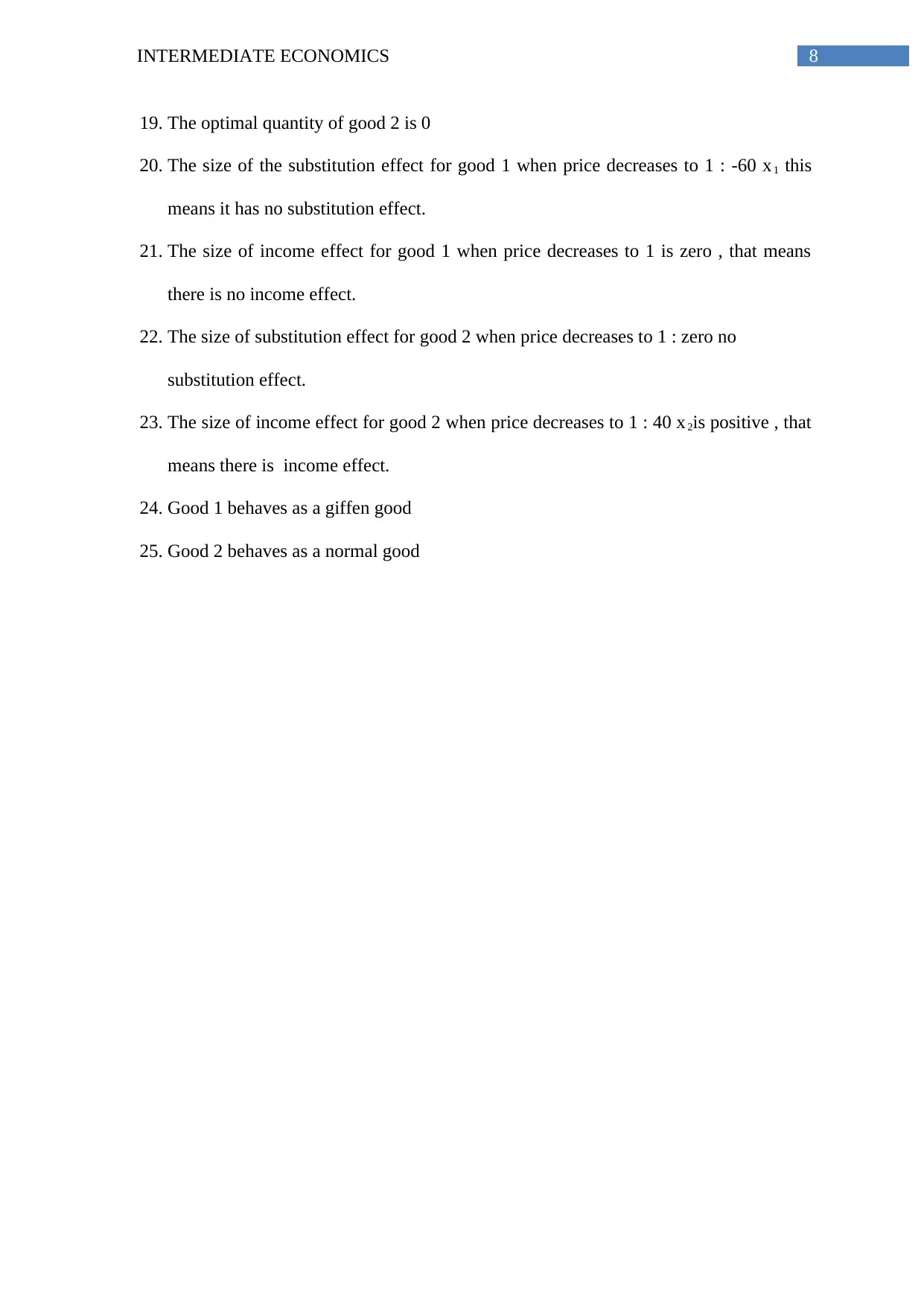
8INTERMEDIATE ECONOMICS
19. The optimal quantity of good 2 is 0
20. The size of the substitution effect for good 1 when price decreases to 1 : -60 x1 this
means it has no substitution effect.
21. The size of income effect for good 1 when price decreases to 1 is zero , that means
there is no income effect.
22. The size of substitution effect for good 2 when price decreases to 1 : zero no
substitution effect.
23. The size of income effect for good 2 when price decreases to 1 : 40 x2is positive , that
means there is income effect.
24. Good 1 behaves as a giffen good
25. Good 2 behaves as a normal good
19. The optimal quantity of good 2 is 0
20. The size of the substitution effect for good 1 when price decreases to 1 : -60 x1 this
means it has no substitution effect.
21. The size of income effect for good 1 when price decreases to 1 is zero , that means
there is no income effect.
22. The size of substitution effect for good 2 when price decreases to 1 : zero no
substitution effect.
23. The size of income effect for good 2 when price decreases to 1 : 40 x2is positive , that
means there is income effect.
24. Good 1 behaves as a giffen good
25. Good 2 behaves as a normal good
⊘ This is a preview!⊘
Do you want full access?
Subscribe today to unlock all pages.

Trusted by 1+ million students worldwide
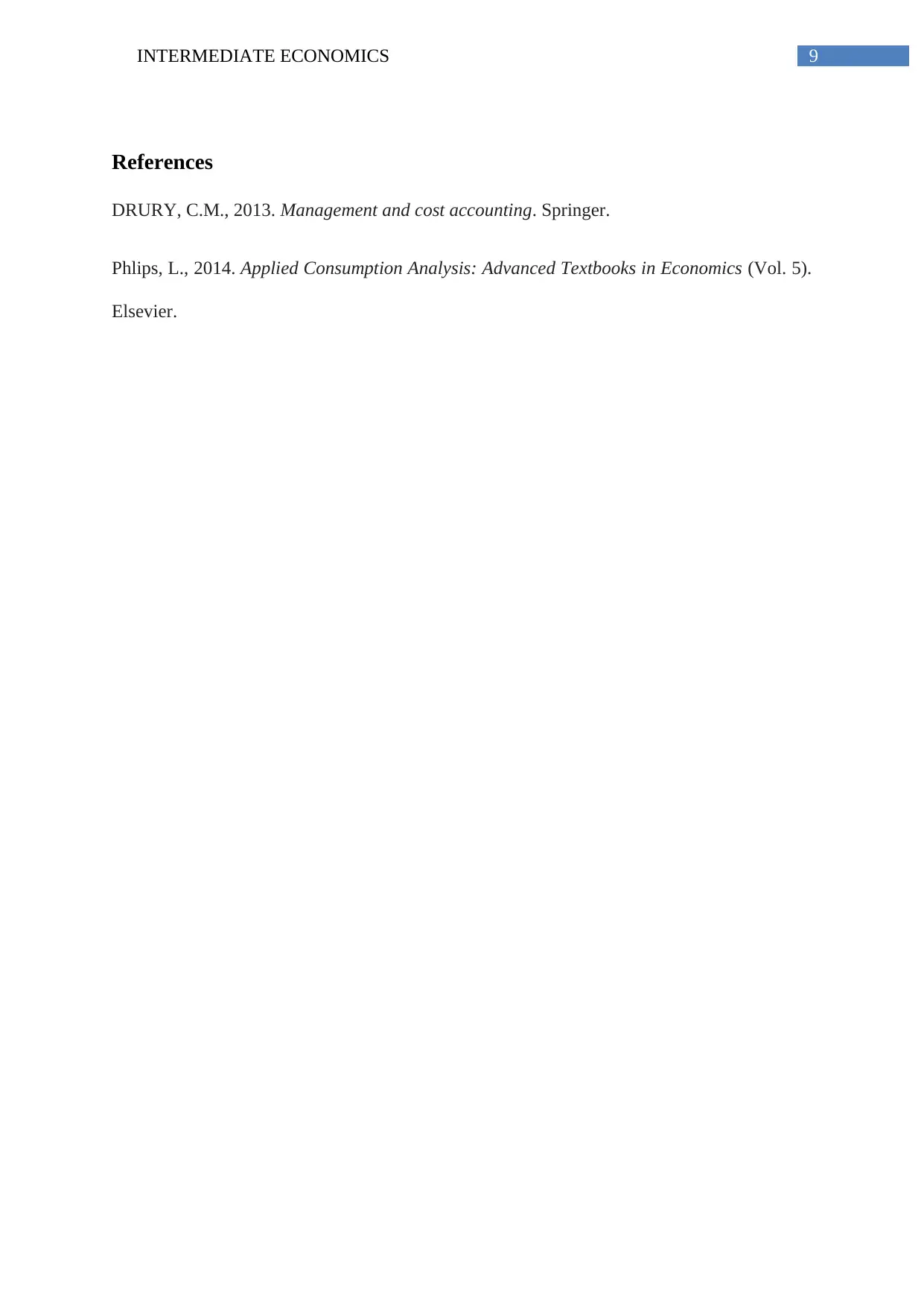
9INTERMEDIATE ECONOMICS
References
DRURY, C.M., 2013. Management and cost accounting. Springer.
Phlips, L., 2014. Applied Consumption Analysis: Advanced Textbooks in Economics (Vol. 5).
Elsevier.
References
DRURY, C.M., 2013. Management and cost accounting. Springer.
Phlips, L., 2014. Applied Consumption Analysis: Advanced Textbooks in Economics (Vol. 5).
Elsevier.
1 out of 10
Related Documents
Your All-in-One AI-Powered Toolkit for Academic Success.
+13062052269
info@desklib.com
Available 24*7 on WhatsApp / Email
![[object Object]](/_next/static/media/star-bottom.7253800d.svg)
Unlock your academic potential
Copyright © 2020–2025 A2Z Services. All Rights Reserved. Developed and managed by ZUCOL.





